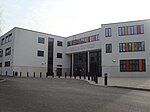The George Hotel, also known as the George Inn and now marketed as the Ramada Crawley Gatwick, is a hotel and former coaching inn on the High Street in Crawley, a town and borough in West Sussex, England. The George was one of the country's most famous and successful coaching inns, and the most important in Sussex, because of its location halfway between the capital city, London, and the fashionable seaside resort of Brighton. Cited as "Crawley's most celebrated building", it has Grade II* listed status.
It is known that a building called the George has existed on the site since the 16th century or earlier, and many sources date the core of the existing inn to 1615. The George Hotel has three principal sections, facing east and running from south to north parallel with Crawley High Street. Nothing of the exterior is original, except perhaps for parts of the tiled roof. The hotel contains 84 rooms and 6 meeting rooms with a capacity of up to 150, regularly used for conferences, weddings, exhibitions, seminars and training sessions. The present structure is made up of disparate parts of various dates: the inn expanded to take in adjacent buildings as its success grew in the 18th and 19th centuries. Major changes took place in the 1930s, and the annex was knocked down in 1933.
The inn has been associated with royalty, bareknuckle prizefighting, smuggling among other things, and has been the subject of novels and paintings. It was central to the plot of Sir Arthur Conan Doyle's mystery novel Rodney Stone, written in 1896. John George Haigh, a notorious serial killer in the 1940s known for his "acid bath" murders, stayed at the hotel on numerous occasions, and dined there on the day he killed one of his victims. The hotel is also reputedly haunted by the ghost of a nightwatchman, Mark Hurston (or Hewton) and other curious figures.








